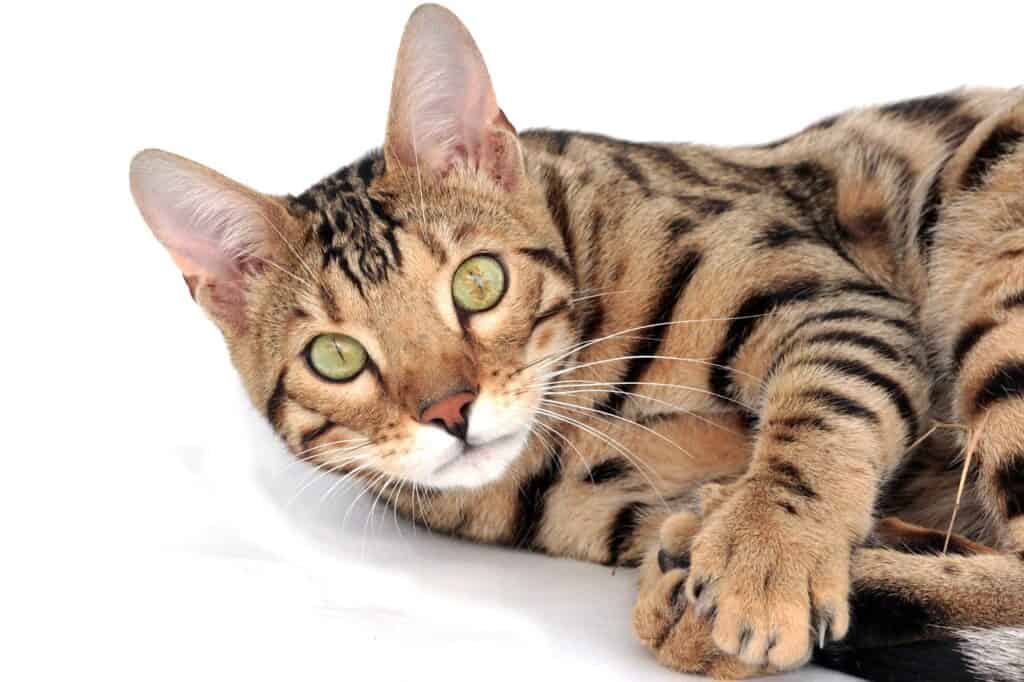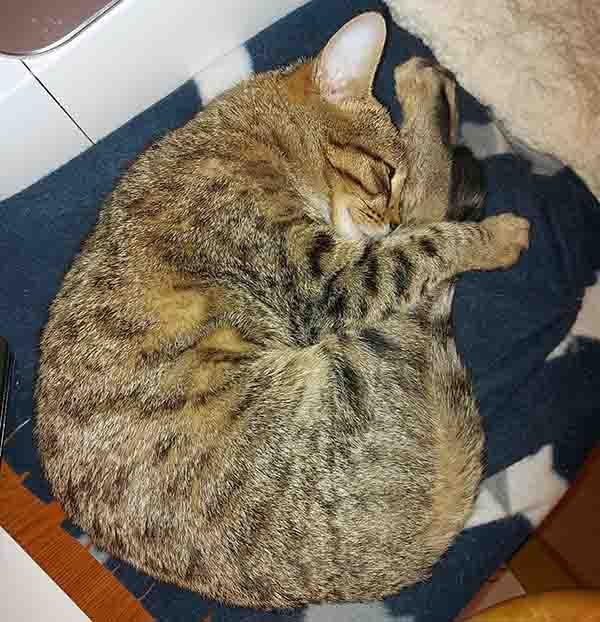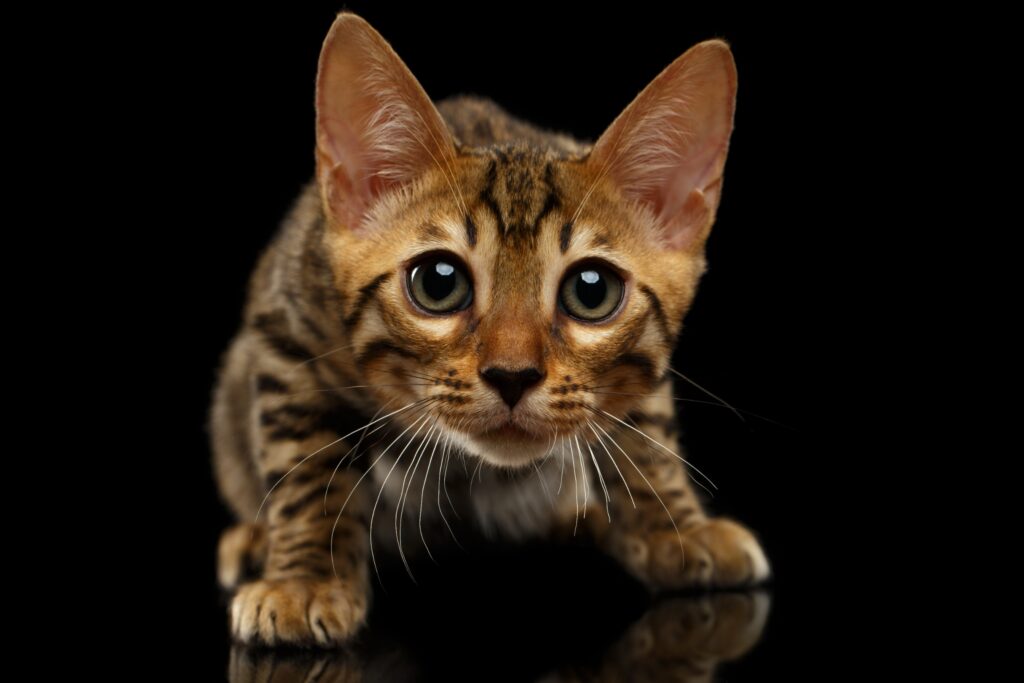A few months back, my Bengal kitten began experiencing issues with walking and jumping. Initially, she struggled with jumping—finding it hard to reach heights, failing to land jumps properly, or even falling. Over time, her condition worsened to the point where she couldn’t jump at all and faced difficulties walking.
After an expensive trip to the vet for a thorough examination and tests, we were still in the dark about her condition. However, she gradually improved over a couple of months and was almost back to her old self when the problem resurfaced, this time more severe than before.
It was only during this second episode that we finally understood what was happening—our poor Roo had developed feline polyneuropathy (also known as cat neuropathy or Bengal cat polyneuropathy).
While I thought I was up to speed on the genetic/inherited diseases of Bengal cats, feline polyneuropathy was a new one to me. Naturally, I set out to learn all I could about this neurological disease of cats, both for my own benefit and to provide critical information to other Bengal cat owners.
What Is Bengal Cat Polyneuropathy?
Polyneuropathy in General
Polyneuropathy, as the name implies, involves multiple peripheral nerves malfunctioning at once. It’s like a systematic outage in a computer network, affecting various parts of the body simultaneously.
There are many different types of polyneuropathies. It can be a consequence of other diseases like diabetes, kidney or liver disease; it can be triggered by infections or exposure to toxins; or it can be a genetic legacy, as seen in Distal Polyneuropathy of Rottweilers and Birman Cat Distal Polyneuropathy.
Typically, the disease progression and prognosis vary widely depending on the underlying cause and the species affected. The symptoms may vary widely depending on which nerves are affected.
When a peripheral nerve malfunctions, it fails to transmit signals properly, leading to an array of potential symptoms. This could be a loss of sensation in the affected areas, as these nerves are responsible for transmitting sensory information back to the brain.
It could also result in motor (movement) difficulties, as peripheral nerves control the muscles and relay commands from the brain for movement. In severe cases, non-functioning peripheral nerves can lead to paralysis.
The topic of polyneuropathy in general is much too big to deal with in a single article. What is of interest to you the reader and me the writer is, of course, polyneuropathy in Bengal cats and that will be the focus of the rest of this article.
Bengal Cat Polyneuropathy
The Bengal cat breed is relatively new, having been officially recognized in the 1980’s. The first report of polyneuropathy in this breed appeared in the published literature in 2008, describing neurologic symptoms in a young Bengal cat that waxed and waned several times over a year (1).
At its worst, the disease affected all four limbs of the cat rendering it unable to walk. Supportive care was provided, and each episode resolved on its own until they eventually ceased to happen altogether.
Another study was published just three years later, describing a “chronic” polyneuropathy in 37 young Bengal cats (2). Cats included in this study recieved veterinary care for clinical signs such as limb weakness, exercise intolerance, a stiff or stilted gait, a plantigrade stance (walking with the heel touching the ground), and decreased jumping ability. Some cats also had muscle loss, weight loss, or stunted growth.
Most of these cats were treated with some sort of medication, with over half of them (60%) receiving a glucocorticoid such as prednisone. Regardless of which treatment they received, or if they received treatment or not, the majority of the cats went on to make complete, or almost complete, recoveries.
The most significant finding in this group of Bengal cats was evidence of demyelination. Demyelination is a process in which the protective covering called the myelin sheath, which surrounds and insulates nerve fibers in the central and peripheral nervous systems, becomes damaged or destroyed.
This damage disrupts the normal transmission of electrical signals along the nerve fibers. The loss of myelin can lead to a range of neurological symptoms, including weakness, numbness, impaired coordination, and other neurological deficits, depending on the location and extent of demyelination.
Demyelination can result in permanent neurologic issues if the demyelination is severe enough. Fortunately, in most cases of Bengal cat polyneuropathy, the myelin sheath regenerates and the cats recover.

How Common Is Polyneuropathy In Bengal Cats?
Polyneuropathy in cats is, in general, described as “uncommon” or “rare” (3). However, the Bengal cat community is beginning to recognize that this disease seems to affect the Bengal breed rather commonly.
There is information circulating on social media and forums that up to 10% of Bengal cats are affected, but there exists no published evidence to support this. “Bengal cat polyneuropathy” is not well known among general veterinary practitioners, and even specialists are not always familiar with it.
If polyneuropathy did indeed occur in 10% of Bengal cats, I would expect most veterinarians to have some experience with the disease, which is not the case. Still, it does occur frequently enough that it would not be considered “uncommon” or “rare”.
It happens often enough that it has its own Facebook group with over 1,000 members.
What Causes Bengal Cat Polyneuropathy?
There are different causes of Feline Polyneuropathy in general, such as infectious causes like toxoplasmosis and feline immunodeficiency virus (FIV); metabolic causes like diabetes and kidney disease; or traumatic causes such as physical injury.
Unfortunately, the cause of Bengal Cat Polyneuropathy is still largely unknown. It falls into the category of “idiopathic”, which means that the cause is unknown or not yet identified.
It’s possible that Bengal Cat Polyneuropathy is an inherited condition, with an underlying genetic component as it does seem to occur with some regularity in this breed of cats.
The underlying mechanism of the disease appears to be autoimmune related, with researchers comparing it to nerve damage in humans resulting from Guillian Barre Syndrome (GBS). GBS is usually associated with a recent viral infection, although there has been a small association with certain vaccines (4).
One might draw parallels between vaccine-induced GBS in people and Bengal Cat Polyneuropathy, given that 75% of the cats in the study on 37 Bengal cats had been vaccinated within the previous two months. However, this is only a hypothesis and further research is needed to confirm or refute this.
Muscle and nerve biopsies from cats affected by this disease show changes that are consistent with an inflammatory process. This usually occurs in response to harmful stimuli, like pathogens, damaged cells, or irritants.
The inflammatory process is a protective attempt by the body to remove these injurious substances and initiate the healing process. However, it can also occur in the absence of harmful stimuli in a condition where the body’s immune system, for some unknown reason, turns upon itself (autoimmune disease).
A series of biochemical events spreads and develops the inflammatory response, involving the nearby blood vessels, the immune system, and different cells in the injured tissue. In the context of Bengal Cat Polyneuropathy, the inflammatory process is likely involved in demyelination of the nerves, resulting in the clinical signs observed.
Symptoms
Bengal Cat Polyneuropathy tends to be a disease of young cats with most new cases occurring in cats less than one year of age, although some cats may have their first episode when they are several years old.
Affected cats show a range of symptoms that reflect the impacted peripheral nerve functions. These may vary from one cat to another but generally include:
- Limb Weakness: The cat may have difficulty moving its limbs, particularly in the hind legs.
- Exercise Intolerance: Affected cats may have decreased endurance and tire easily.
- Altered Gait: The cat may walk with limp, or a stiff or stilted gait, often characterized as a plantigrade stance where the heel touches the ground.
- Decreased Jumping Ability: Cats with this condition may struggle with or avoid jumping activities.
- Weight Loss: Some cats may experience weight loss or have difficulty maintaining their weight.
- Stunted Growth: In younger cats, the disease may interfere with normal growth and development.
- Muscle Atrophy: Some cats may show signs of muscle loss, particularly in the limbs.
- Neurological Deficits: Depending on the extent of the demyelination, cats may experience other neurological symptoms such as numbness, impaired coordination, and in severe cases, inability to walk.
These symptoms can also be caused by other health issues, and a veterinarian should always be consulted for an accurate diagnosis.
Symptoms are typically progressive, starting mild and then increasing in severity over a period of time that can range from days to weeks.
Cat parents often don’t recognize the first early signs as they can be very subtle, such as the cat is playing less often, isn’t jumping as high as it used to, or other changes in behavior.

Diagnosis
Bengal Cat Polyneuropathy is largely a diagnosis of exclusion, meaning that other potential causes of your cat’s symptoms should be ruled out before arriving at a definitive diagnosis.
This may include testing for infectious diseases, metabolic disorders, and other neurological conditions, as well as x-rays to rule out any bone or joint abnormalities.
Here’s an overview of how the diagnostic process works:
Clinical Evaluation
- Physical Examination: A veterinarian will perform a thorough physical examination of the cat to assess its overall health and neurological status. They will look for symptoms such as muscle weakness, tremors, incoordination, and difficulty rising.
- Medical History: The vet will take a detailed medical history from the cat owner, including information about the cat’s age, breed, and the onset and progression of any neurological symptoms.
Rule Out Other Conditions
- Blood Tests: Laboratory tests will be performed to check for signs of infection, metabolic disorders, and other potential causes.
- X-Rays: X-rays may also be taken to look for any bone or joint abnormalities that could potentially cause the symptoms observed in your cat.
Diagnostic Procedures (if necessary)
- Nerve Biopsy: In some cases, a nerve biopsy may be recommended to confirm the presence of demyelination in the affected nerves. A small sample of nerve tissue is typically taken and examined under a microscope.
- Electromyography (EMG): EMG is an electrical study that assesses the function of muscles and the nerves that control them. It can help identify abnormalities in nerve function and may be used to support the diagnosis.
- Other Imaging Tests: In some instances, advanced imaging techniques like MRI (Magnetic Resonance Imaging) or CT (Computed Tomography) scans may be used to evaluate the nervous system and rule out other potential causes of neurological symptoms.
- Veterinary Specialist Consultation: A veterinary neurologist or specialist may be consulted to provide a more detailed evaluation and assist in confirming the diagnosis.
In many cases, the diagnostic process will end once other possible causes of the cat’s symptoms have been ruled out, leaving Bengal Cat Polyneuropathy as the most likely diagnosis and developing a treatment plan accordingly.
However, some cat parents may want to pursue every angle possible. Nerve biopsies and EMG testing can help support or confirm the diagnosis of polyneuropathy, while MRI or CT may be recommended to rule out less common causes that cannot be detected by other means.
Treatment
Unfortunately, there is no “cure” or specific treatment for Bengal cat polyneuropathy. Cats that experience neurological symptoms should be seen by a veterinarian to rule out potentially life-threatening causes and to provide supportive care.
Supportive care typically includes medications to reduce inflammation, manage symptoms, and reduce discomfort. Some cats may also benefit from physical therapy or rehabilitation to help maintain muscle tone and improve mobility and quality of life.
Cats with more severe symptoms, such as paralysis of all four limbs, require more intensive treatment. These cats may need to be hospitalized for supportive care, such as fluids and medications.
Prednisone is often prescribed for cats with this condition. Prednisone works to decrease inflammation and dampen the immune system which, in theory, addresses the two main suspect mechanisms causing the polyneuropathy.
Anecdotally, many cat owners report significant and rapid improvement in their cats’ symptoms once prednisone treatment has started. However, many cats that do not get prednisone can also have the same rapid improvement.
In a nutshell, there is no hard proof that prednisone is an effective treatment, nor is there proof it is not. Discuss the pros and cons with your veterinarian – often the approach is to use prednisone unless there is a reason not to, such as another preexisting health condition where prednisone is contraindicated.
Other medication options your veterinarian may discuss with you are anti-inflammatory medications other than prednisone, and nutritional supplements such as vitamin B12 to support nerve health.
Many cat parents also turn to CBD oil, which has been shown to reduce pain associated with polyneuropathy in humans. While CBD oil is generally considered safe to use in cats, there is a lack of scientific data to support its use for pain control in cats.
Veterinarians are typically prohibited from prescribing CBC by their licensing bodies, so while your vet may be willing to discuss this with you, they are unlikely to actually prescribe it for your cat.
Check out this video below about Benji, a Bengal cat with polyneuropathy involving all four limbs. Despite being more severely affected than many cases, with treatment and physiotherapy Benji was able to recover and live a normal live.
Long-Term Prognosis
The good news is that most Bengal cats who get polyneuropathy recover without permanent nerve damage or significant disability. In some cases, cats may be left with a slight gait abnormality or weakness in one limb that persists after treatment has stopped.
Cats may have recurrent episodes, which may require treatment or resolve spontaneously on their own. Many cats, especially those that have their first episode when less than a year old, seem to “grow out” of it within a year or two and go on to have normal, healthy lives.
The long-term outlook for Bengal cats with polyneuropathy depends on the severity of symptoms at presentation. Those that have the most severe symptoms are the most likely to have permanent nerve damage. A small percentage may be affected so severely that they do not recover and the only humane option left is euthanasia.
Fortunately, the majority of cases do not progress to the point where they are permanently debilitated or are unable to recover at all.
It’s important to remember that if your cat has been diagnosed with polyneuropathy, it’s still possible that other conditions may coexist or be contributing factors to your cat’s neurological symptoms. Making sure other underlying medical conditions are treated and managed can help your cat live a happy, healthy life.
Conclusion
Finding out that your Bengal cat has been diagnosed with polyneuropathy can be overwhelming. The initial shock and uncertainty can bring up a mix of emotions for cat parents.
But it’s important to remember that while this condition may have its challenges, the prognosis for the majority of cats is very good. What matters most is the proactive approach you take as a cat parent.
In the face of this disease, arming yourself with knowledge and understanding is key to helping your cat. Through proper diagnosis and treatment, you can help your Bengal cat manage any symptoms and achieve a long, happy life.
Sources:
- https://pubmed.ncbi.nlm.nih.gov/18555719/
- https://pubmed.ncbi.nlm.nih.gov/21689154/
- https://www.ncbi.nlm.nih.gov/pmc/articles/PMC4668811/
- https://www.cdc.gov/vaccinesafety/concerns/guillain-barre-syndrome.html
- https://www.ncbi.nlm.nih.gov/pmc/articles/PMC7128390/
- https://www.ncbi.nlm.nih.gov/pmc/articles/PMC4668811/
- https://onlinelibrary.wiley.com/doi/abs/10.1111/j.1748-5827.2000.tb03228.x?sid=nlm%3Apubmed
- https://www.annualreviews.org/doi/full/10.1146/annurev-animal-081122-070236

